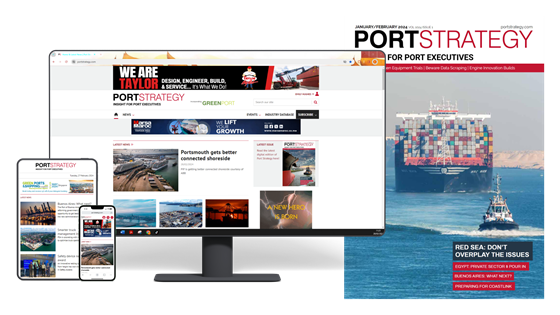Container & Cargo Handling – Page 76
-
News
Environmental considerations
Cemex UK''s new cement grinding and blending facility at Tilbury will be located right in the middle of the dock area and receive at least 50% of its raw materials by water.
-
News
Double vision
The need to boost productivity not only on the quayside but also in the yard is forcing the switch to twin- and quad-lift spreaders,reports Alex Hughes
-
News
Liscont emerges from handling cocoon with full RTG operation
Portugal''s deep-sea container terminal, Liscont, is in the final stages of transforming its yard into a completely rubber-tyred gantry-based (RTG) operation.During Port Strategy''s visit to the terminal in February, a new yard management system had just gone live, although terminal manager Carlos Figueiredo conceded that the thick fog enveloping the ...
-
News
The power of optical character recognition
Optical character recognition (OCR) is a "tremendously powerful technology which nicely complements an efficient gate operating system", says Tideworks''Harvey Bauer.
-
News
Future-proofing
The trick is to design a low cost terminal with an early start-up,which is ready for future expansion, as Felicity Landon finds out
-
News
Stacking high
How high to stack? Many rubber-tyred gantry (RTG) yards stack one over five and there is talk of one over six becoming more commonplace, says Royal Haskoning''s Jonathan Tyler.
-
News
Crowning glory
A glistening future beckons as Shanghai proves its dominance in the port world. Wing Kah-goh reports
-
News
Shaking new ground
Regarded as very flexible but ''energy hungry''machines, pneumatic unloaders for bulk product are getting more sophisticated and are making use of new types of energy-efficient electronic controls. David Foxwell reports
-
News
Call in the Experts
As terminal throughputs rocket and crane technology becomes increasingly complex,more operators are turning to outside specialists for their equipment maintenance. Felicity Landon reports
-
News
Hands-on approach
In the Port of Liverpool, equipment maintenance at the Seaforth Container Terminal is outsourced - but through some very clearly defined contracts, and the management of these contracts remains with Mersey Ports, says chief engineer Tim Bownes.
-
News
Frontline focus
The Port of Felixstowe employs 230 engineers and the majority of its frontline maintenance - including quay cranes and yard cranes - is carried out in-house, supported by specialist contractors, says Hutchison Ports (UK) spokesman Paul Davey. "We do use some third party contractors and suppliers to maintain other hired ...
-
News
What customers want
Kalmar Industries says customers have many reasons for looking towards outsourcing of maintenance and support services. As well as obvious factors such as flexibility and cost reductions,port operators often have a lack of skilled people.
-
News
Taking the pain out of ports
Consultants can deliver the planning pill to solve complicated design problems. Alex Hughes investigates how two challenging schemes have been tackled
-
News
Don't forget safety
It is not only the cynics who know the price of everything and the value of nothing. This is a quality of character occasionally displayed by the upper echelons of management in port, transport and energy organisations. We can take as our example the recent strictures applied to the leadership ...
-
News
Room for two
Undeterred by neighbouring Dubai''s bid to build a regional superport,Abu Dhabi is breathing new life into a decade-old port development plan. Alex Hughes reports
-
News
Locking on to labour
Buoyed by booming throughput,Antwerp has set its targets on modernising work practices. Felicity Landon reports
-
News
Coals from Newcastle
Australia is taking advantage of the dry bulk boom to push through port developments as David MacIntyre finds out
-
News
Conveying the load
Moving coal from A to B is simply not enough. Today''s coal handling systems need to offer more, as Iain MacIntyre explains
-
News
A question of classification
Crane classification is increasingly important in the market, but what does it mean? A crane must be a high-performance machine,with high lifting capacities, but what use is a powerful crane if it ends up on the scrap heap after a few years?
-
News
Upwardly Mobile
Globalisation, privatisation, competition and cost pressures are driving changes in the cargo handling business and in the design and construction of mobile harbour cranes, as David Foxwell finds out
















